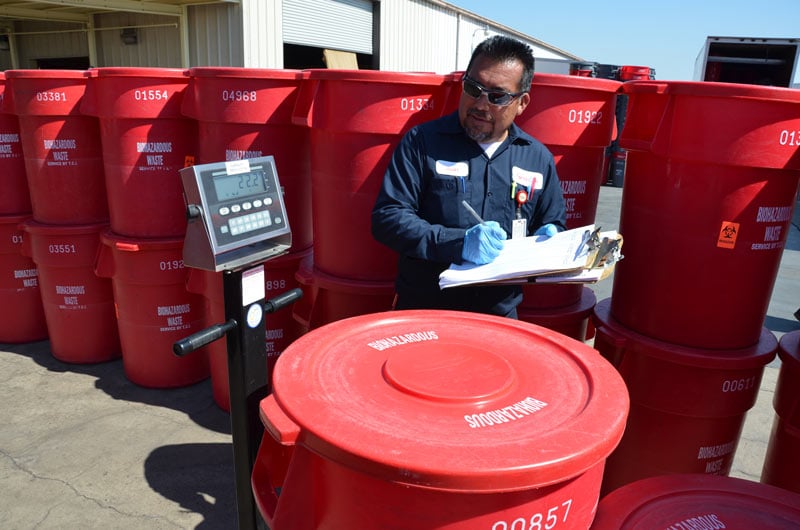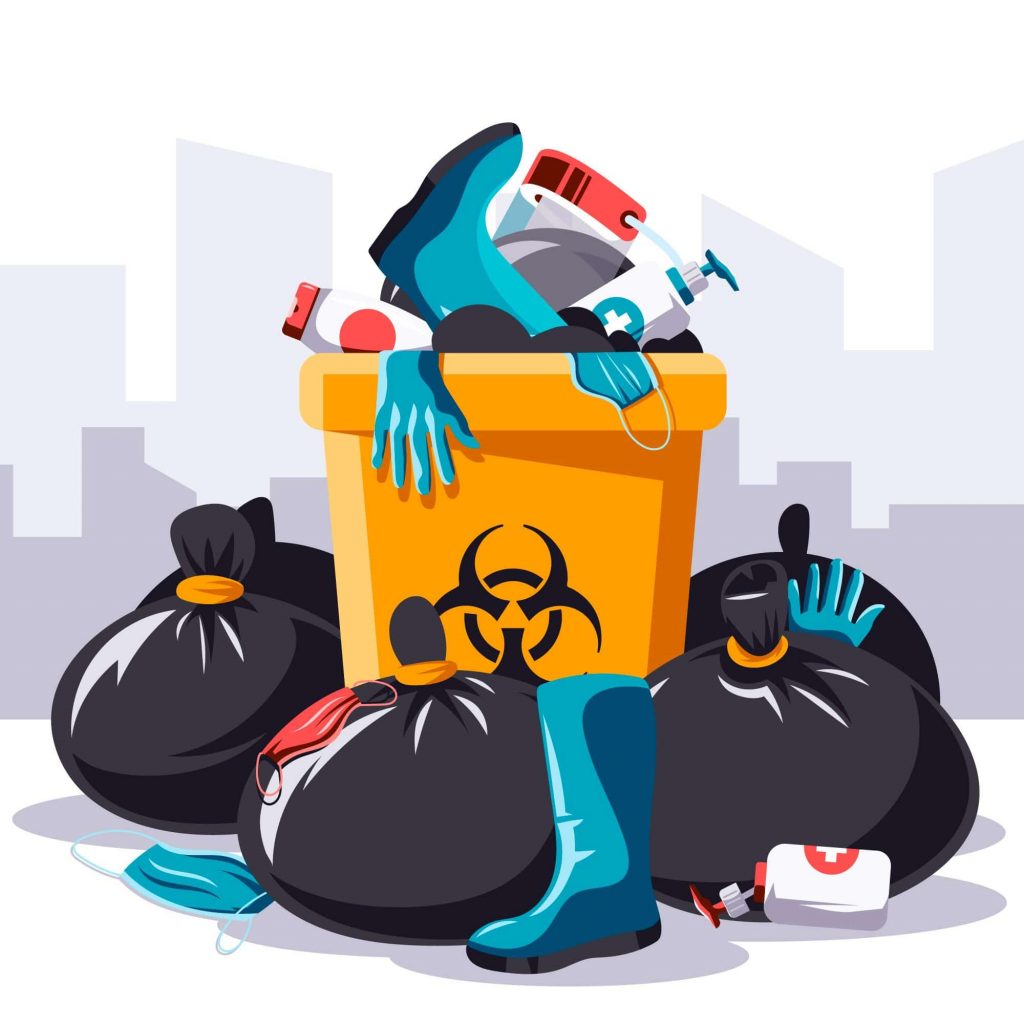Best Practices for Medical Waste Monitoring
Clinical waste administration is a vital facet of healthcare centers' procedures to make sure the safety and security of individuals, personnel, and the setting. Applying best techniques in medical waste management is essential to decrease the risks linked with unsafe waste.

Segregation and Classification
In the field of medical waste administration, appropriate partition and classification are essential practices for making sure the reliable and safe disposal of healthcare-related materials. Medical waste is created from different sources, consisting of hospitals, facilities, labs, and various other medical care centers. It is composed of a large range of products, such as needles, syringes, bandages, gloves, and pharmaceutical waste.
Segregation involves the organized splitting up of various kinds of medical waste based on their attributes and potential dangers. Sharps waste, such as blades and needles, should be placed in puncture-resistant containers to avoid injuries and the spread of contagious conditions.
Categorization is the process of categorizing medical waste into various classifications based on its prospective hazards. These groups may consist of infectious waste, unsafe waste, pharmaceutical waste, and general waste. By categorizing waste, health care centers can figure out the proper disposal methods and ensure conformity with neighborhood guidelines and standards.
Proper partition and classification of clinical waste not just safeguard the health and security of healthcare employees and the basic public but also add to the general performance and performance of waste administration. It lowers the danger of mishaps, lessens ecological effects, and advertises accountable garbage disposal practices.
Proper Storage and Labeling
To ensure the efficient and risk-free disposal of clinical waste, health care facilities have to follow proper storage and labeling methods. WasteX Medical Waste Disposal. Appropriate storage and labeling play a critical role in preserving the stability of clinical waste management systems and safeguarding the health and wellness of health care employees, clients, and the public
When it comes to storage, it is vital to have marked locations particularly developed for various sorts of medical waste. These areas must be safe, well-ventilated, and equipped with ideal containers that fulfill regulative standards (medical waste disposal service). Partition and categorization of waste need to additionally be taken right into factor to consider to avoid cross-contamination and prospective risks

Routine monitoring and assessment of storage space areas and containers are essential to identify any type of concerns or offenses. Personnel ought to be trained on proper storage space and labeling practices, stressing the relevance of compliance with laws and methods.
Safe Transport and Handling
Guaranteeing the safe and secure and correct transportation and handling of medical waste is vital for maintaining the stability of waste management systems and safeguarding the health and wellness and safety and security of all entailed. Medical waste, that includes items contaminated with transmittable products, drugs, and other harmful substances, must be transported in a manner that avoids leaks, spills, and possible contamination.
To achieve risk-free transportation and handling, numerous finest practices need to be adhered to. It is essential to use leak-proof and puncture-resistant containers that are specifically designed for medical waste. These containers must be effectively secured and identified to avoid any kind of unexpected direct exposure or messing up. In addition, waste needs to be segregated based upon its nature and kind to stop cross-contamination.
Throughout transport, it is important to ensure that waste containers are securely secured and stored in a stable fashion. Autos used for moving clinical waste needs to be outfitted with proper security functions, such as spill containment systems, to lessen the risk of any spills or leakages. Vehicle drivers need to receive training on appropriate handling and emergency feedback treatments to successfully deal with any type of unpredicted cases.
Moreover, the transport and handling of medical waste should follow all go to my site relevant laws and standards stated by local, state, and government authorities. WasteX Medical Waste Disposal. medical waste removal. Regular examinations and audits should be performed to analyze compliance and determine any type of locations for renovation
Conformity With Regulatory Guidelines
Maintaining conformity with governing standards is necessary for efficient clinical waste management. These standards are implemented to safeguard public wellness and the atmosphere by making sure that clinical waste is appropriately taken care of, treated, and disposed of. Compliance with governing guidelines helps to stop the spread of transmittable diseases, decrease prospective dangers, and minimize the general impact of clinical waste on the atmosphere.
To attain conformity, healthcare centers should stay educated about the details policies governing clinical waste monitoring in their territory. These regulations may differ from country to nation, and also within various states or areas. It is very important for health care facilities to have an extensive understanding of these standards and to apply suitable approaches and methods to guarantee compliance.
One key facet of conformity is the appropriate segregation and labeling of different types of clinical waste. This consists of separating sharps from other waste, along with classifying waste based upon its potential threats. Medical care facilities need to additionally make certain that clinical waste is stored in proper containers which these containers are appropriately labeled and secured.
Furthermore, conformity with regulatory guidelines requires health care facilities to develop proper training and education programs for personnel associated with medical waste administration. This includes giving training on waste partition, taking care of, and disposal treatments, in addition to the proper use of individual safety tools.
Regular surveillance and audits are likewise necessary to ensure continuous conformity with regulative guidelines. This involves conducting normal evaluations of waste storage locations, recording waste management treatments, and maintaining records of waste disposal.
Effective Disposal Approaches
Health care facilities must use effective disposal methods for appropriate management of medical waste. Incorrect disposal of medical waste can pose severe health and wellness and environmental dangers. There are numerous methods that can be utilized to properly deal with clinical waste, making sure the safety of healthcare workers, individuals, and the general public.
One frequently made use of approach is incineration. Burners can securely shed clinical waste at heats, lowering the quantity and ruining any type of potentially unsafe virus. Incineration can be pricey and might launch harmful contaminants right into the air if not correctly controlled.
An additional technique is autoclaving, which includes subjecting the waste to high-pressure steam. This process eliminates germs, viruses, and various other microorganisms, making the waste safe for disposal in normal waste streams. Autoclaving is a environmentally pleasant and reliable approach, but it requires specific equipment and experienced workers.
Chemical disinfection is likewise used in many cases, where liquid chemicals are related to the waste to disinfect it. This method is less typically used because of problems about the effectiveness of chemical sanitation and the potential for chemical deposits to pollute the atmosphere.
Along with these techniques, healthcare centers should also execute proper partition, packaging, and labeling of medical waste to guarantee its risk-free handling and disposal. Regular training and education of staff on proper waste monitoring practices are crucial to preserving efficient disposal methods.
Conclusion
Finally, executing ideal techniques for medical waste administration is important for making sure the safety of health care workers, people, and the environment. By effectively setting apart and classifying waste, storing and classifying it properly, making sure risk-free transportation and handling, adhering to regulative guidelines, and employing reliable disposal approaches, medical care centers can efficiently manage and lessen the threats connected with medical waste. It is crucial for medical care companies to focus on and adhere to these finest techniques to maintain a risk-free and lasting healthcare environment.
Clinical waste administration is an important element of health care centers' procedures to make sure the safety and security of people, team, and the setting. Executing ideal methods in clinical waste monitoring is necessary to minimize the threats connected with hazardous waste. These groups might consist of transmittable waste, harmful waste, pharmaceutical waste, and basic waste.In conclusion, applying best techniques for medical waste management is vital for guaranteeing the safety of healthcare workers, patients, and the atmosphere. By correctly categorizing and segregating waste, saving and identifying it correctly, making sure safe transportation and handling, conforming with regulatory guidelines, and utilizing effective disposal approaches, medical care centers can effectively take care of and minimize the risks associated with clinical waste.